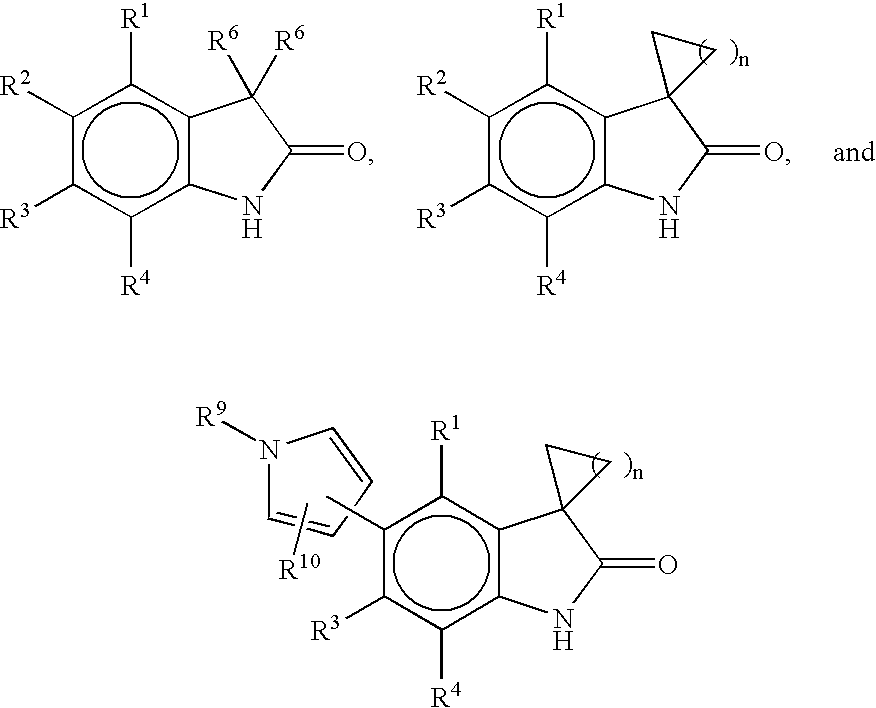Process for the synthesis of progesterone receptor modulators
a progesterone receptor and synthesis technology, applied in the field of progesterone receptor modulator synthesis, can solve the problems of long reaction time (2,5 days), less desirable route, and procedure from large-scale us
- Summary
- Abstract
- Description
- Claims
- Application Information
AI Technical Summary
Problems solved by technology
Method used
Image
Examples
example 1
Preparation of 4′-fluorospiro[cyclopropane-1,3′-indolin]-2′-one
[0076]2,6-difluoro-phenylacetonitrile (306 g, 2.0 mol) was added to a mixture of 50% NaOH (800 g, 10 mol) solution, catalytic amount of Bu4NBr (25.8 g, 0.08 mol) and BrCH2CH2Br (750 g, 4.0 mol) over 90 minutes. The temperature of the reaction mixture increased and the temperature was maintained at 35-45° C. After addition, the reaction temperature was adjusted to 45±2° C. and stirred for 2 hours. Water was then slowly added, the reaction mixture was cooled to 20-25° C., and methyl t-butyl ether (2000 mL) was added. The organic phase was separated, concentrated by vacuum distillation and chased with t-amyl alcohol (612 ml) to remove water and unreacted BrCH2CH2Br. The residue was dissolved into t-amyl alcohol (1530 mL).
[0077]Potassium hydroxide (KOH; 281 g, 5.0 mol) was added to this mixture, the reaction mixture was heated to 70±2° C., and the mixture was stirred for 1 hour. Upon completion, the reaction mixture was cool...
example 2
Preparation of 5′-bromo-4′-fluorospiro[cyclopropane-1,3′-indolin]-2′-one
[0079]A slurry of N-bromosuccinimide (254 g, 1.43 mol) in 3 parts of water (798 mL) was added to a slurry of 4′-fluorospiro[cyclopropane-1,3′-indolin]-2′-one (266 g, 1.50 mol) in a mixture of 3 parts of water (798 mL) and 3 parts of acetonitrile (798 mL) at 20-25° C. over 1 hour. A slight exothermic reaction was observed. After addition, the reaction mixture was stirred for 1 hour at 20-25° C. Upon completion, 3 parts of water (798 mL) was added, the mixture was cooled to 0-6° C., and the mixture was stirred for 30 minutes. The solid was collected by filtration, washed with water, and dried at 55° C. / 18 hours / 10 mm Hg to give the product (350 g) in 94% yield. 1H NMR (CDCl3): δ 8.79 (s, 1H), 7.38 (m, 1H), 6.71 (d, 1H, J=8.3 Hz), 1.96 (m, 2H), 1.78 (m, 2H).
example 3
5-(4′-fluoro-2′-oxo-1′,2′-dihydrospiro[cyclopropane-1,3′-indol]-5′-yl)-1-methyl-1H-pyrrole-2-carbonitrile
[0080]A mixture of 5′-bromo-4′-fluorospiro[cyclopropane-1,3′-indol]-2′(1′H)-one (10.0 g, 39.1 mmol), 5-[1,3,6,2]dioxazaborocan-2-yl-1-methyl-1H-pyrrole-2-carbonitrile (4.30 g, 19.5 mmol), Na2CO3 (4.97 g, 46.9 mmol), acetonitrile (150 mL), water (50 mL), and PdCl2(PPh3)2 (0.301 g, 0.391 mmol) was heated to reflux for 1 hour. 5-[1,3,6,2]dioxazaborocan-2-yl-1-methyl-1H-pyrrole-2-carbonitrile (12.8 g, 58.4 mmol) was then added in three portions every hour. The mixture was heated to reflux for 1 hour and then the reaction mixture was cooled to room temperature. The organic solvent was removed by distillation. The crude solid was filtered, washed with a mixture of water and acetonitrile (1:1, v / v, 3×10 mL), and dried to give a crude solid.
[0081]The crude solid was dissolved in ethylacetate (EtOAc; 60 mL) at reflux. A solution of N-acetyl-L-cysteine (0.64 g, 0.391 mmol) in water (15 mL)...
PUM
 Login to View More
Login to View More Abstract
Description
Claims
Application Information
 Login to View More
Login to View More - R&D
- Intellectual Property
- Life Sciences
- Materials
- Tech Scout
- Unparalleled Data Quality
- Higher Quality Content
- 60% Fewer Hallucinations
Browse by: Latest US Patents, China's latest patents, Technical Efficacy Thesaurus, Application Domain, Technology Topic, Popular Technical Reports.
© 2025 PatSnap. All rights reserved.Legal|Privacy policy|Modern Slavery Act Transparency Statement|Sitemap|About US| Contact US: help@patsnap.com



